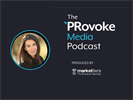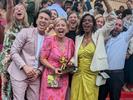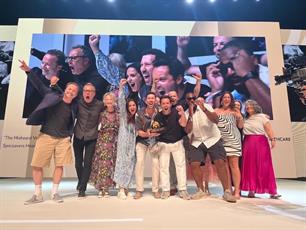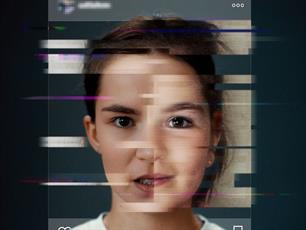Diana Marszalek 02 Jul 2024 // 7:12PM GMT

Nearly two weeks ago at the 2024 Cannes Lions, Weber Shandwick’s ‘First Edible Mascot’ work for Kellanova Pop-Tarts has won a Grand Prix for brand experience & activation, becoming the first-ever PR agency to win the award in the category.
Led by Weber Shandwick in partnership with client Kellanova, as well as with Florida Citrus Sports, Publicis, and others, ‘The First Edible Mascot’ was Pop-Tarts’ single biggest earned campaign ever. The initiative revolved around making a mascot out of a giant Pop-Tart with limbs at college football’s Pop-Tart Bowl — and serving players an edible version of the toaster pastry post-game.
‘The Edible Mascot’ garnered more than 4 billion impressions, acquired $1 million worth of 1P data and generated 15 times more brand mentions than the 10 other non-Kellanova-sponsored bowl games combined.
In an interview with PRovoke Media, Weber Shandwick executive VP Kristin Petersen, the agency’s Kellanova client lead, and Heidi Ray, senior director of brand marketing for Pop-Tarts, discuss origins, execution and success of the campaign.
This is a big year for Pop-Tarts.There was the movie (“Unfrosted) and now the Grand Prix win. Tell me about us about this moment. Pop-Tarts have been around a long time, but this is next level.
HR: It is. everybody knows us. We grew up with Pop-Tarts, right? This is actually our 60th birthday year. We have always played a role in culture; leading culture has been an important part of who the brand is. I mean, it started way back in the day when we took toast and jam and we turned it into something crazy amazing that millions of people have enjoyed for years and years. The purpose of the brand and its core is to spark a rebellion from everyday expectations. And we do that with flavor and fun. And so I think keeping that true to the core of all that we activate has been one of the key tenants as we think about what's happened over the course of the last few years. I know that that the bowl games (activation) sort of burst on the scene. And it may seem like it was an overnight success. But for a long time, we have acted in a way that identifies communities that we care about and engage with them. So, we have a lot of examples of other things that we have done. I think that the bowl game just sort of took the world by storm and it was one of those places where we moved to a much bigger stage. And we're going to see how much love that there is in the world for our brand.
As you’ve said, Pop-Tarts has earned other accolades over the years. But how do you feel winning a Grand Prix? Were you expecting it?
KP: It’s so fun to talk about it because, for us, we’re always looking to create work that adds value. And to see the reception to that, to create something that had this reaction from everyday people, I think is something you always strive for both when it comes to brand love and our own individual careers; creating something that matters. I think what we saw, as Heidi said, is maybe the world was ready for something fun, and you know, crazy good and to have that moment, that there's a place for is the the weird, the uncomfortable, that unexpected. When you think of the level of creativity, and what we're able to achieve, there's really no greater honor.
HR: Professionally it was incredibly gratifying. When the team told us (of the win), there were you know, tears of course. The thing that's just so awesome is that we approach this with keeping the brand and the brand's DNA at the core. We had a little fun and didn't take ourselves too seriously, and people loved it. And it was a bold move, you’re kind of putting yourself out there in this way with an idea could be a little weird. But it was right for the brand. And so seeing our fans and fans of college football being reintroduced to Pop-Tarts and having so much fun with it, I mean, it was just incredible. To be recognized by our peers and by the creative leaders of the industry in this way with the Grand Prix brought us all full circle.
KP: It also says a lot about the power of team and partnership and trust, which to me, has been what is such a monumental part of the celebration — that we have the opportunity to work with a wonderful team like Kellanova and Heidi and Pop-Tarts. And then I think about my massive internal team who pursued the potential — what we can achieve vs. what we can’t do. We were so lucky first of all to work with such an amazing iconic brand that's about challenging convention and dialing up crazy good so that you're starting from of strength And then really Heidi and team empowering us to interpret what that means for culture and for people.
What was the brief?
HR: I think we were fortunate enough to have an opportunity to pick up the game. And our strategy for the year had been to see how consumers ‘eating behaviors are evolving. There's more snacking than ever. We have been an icon of breakfast for 60 years. But as we think about evolving with our consumer, we knew that we needed to expand outside of just breakfast. So, this was like, okay, let's pick a sort of quintessential environment and occasion and start to introduce the world to the idea that Pop-Tarts is an anytime, anywhere indulgent treat. So, this game is the backdrop was the perfect place to start introducing this notion.
And then you have to make that giant Pop-Tart. How does that get done?
KP: A massive team of very creative, forward-thinking problem-solving team members is what I would say, and really a team that so dedicated across both of our groups to planning for and looking at every moment because we knew to that point we had to deliver. We started to see the noise and the fervor once we got our first edible mascot out there. We had raised the stakes. We knew this had to have that humor, that weirdness, right to give people something that they're going to want to engage with and react to. I think we were very judicious about how far we go so that it was landing in this place of fun and dark humor that was acceptable.
How long did you work on bringing this idea of life?
HR: I would love to say that for 18 months we were planning, that we were well ahead. Unfortunately, this the opportunity to pick up the bowl (sponsorship) came to us fairly late in the I guess bowl season cycle. We picked it up late April and had to announce it late May. And so we had from May until December to kind of learn about college football and introduce ourselves to the good folks at Florida Citrus Sports, who are amazing on-the-ground partners, and then brief the team and be off to the races. The moment we announced that we were going to do this, we had so much fun listening to fans, both college football fans as well as like Pop-Tart diehard fans. The speculation as to what we would do started. We wanted to make sure that the work that we did had that backbone of being like it was built for the internet, the meme-ready world that we live in. We built this program around all of the rituals that you can intercept and sort of turn on their head – having a mascot being one of them. We also took over the concession program at the stadium, had some fun with that, and made the (football-shaped trophy with two slots to hold real Pop-Tarts). So there was like all of these points along the journey of the sort of the execution of the idea that allowed us to truly have some fun with the brand and with the space and be true to ourselves but also provide a backdrop for people to join in.
When did you first know the idea worked?
KP: There was a moment when we were all watching the game and you started to feel there was something special. I think about the fact that for the first time I think my parents understood what I do. So you started to see and hear and feel the momentum. You started to hear the broadcasters talk about Pop-Tarts. And then it was again and again. And it's it took off in a way that I think as we were sitting there watching, that we started to realize that all of those discussions we had behind the scenes, all of those pieces were putting together was really moving toward to this place where people
took it ran with it, engage with it, talked about it. And then we started to see all of the memes and the social conversation in a way that I don't know that we've experienced before.



































.jpg)


















